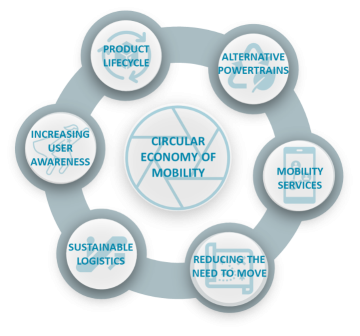Can circular economy of mobility help Baltic Sea region countries achieve their CO2-reduction targets?

Eemil Rauma,
Chief Impact Officer (CIO),
ITS Finland ry,
Finland
Transport sector is responsible for around 20 % of Baltic Sea region CO2-emissions1 and is one of the largest final energy consumption sectors. Transport sector is also one of the most important sectors affecting Baltic Sea regions economic development. Prices of vehicles and gas play large role in household consumption and heavily effect regional economy, as Germany and Sweden are traditional automotive powerhouses and Finland is rising as such due to electric mobility revolution. In short sector`s role in achieving the ambitious climate goals of Paris agreement while at the same time ensuring social and economic welfare is fundamental.
At the 26th UN Climate Change Conference automotive sector announced various electrification and zero-emission targets stating that the last internal combustion engine (ICE) vehicles are to be sold between 2035-2040. Electric vehicles reduce vehicle life-time emissions between 30 and 80 % in the Baltic Sea region countries2 so these news sound good.
However, many residents of Baltic Sea region economies do not afford electric vehicles by 2030 even though their prices are expected to be lower than equal ICE-vehicles then3. How can we then enable socially and environmentally just transition for the citizens?
One answer is circular economy, that can be described as following:
- Economic model meaning a simplified version of reality that allows us to observe, understand, and make predictions about economic behavior
- Which does not focus on producing more and more goods, but in which consumption is based on using services
- Sharing, renting and recycling – instead of owning
- Materials are not destroyed in the end, but are used to make new products over and over again
Above noted principles of circular economy can also be applied to transport sector in which they have fundamental effects on how societies prepare to reduce transport sector CO2-emissions while simultaneously providing just transport service level for all.

Figure 1: By applying principles of circular economy to transport sector, we receive holistic model describing, how circular economy principles change mobility.
Circular economy is foremost about changing ineffective and wasteful business models towards sustainable ones, that enable green mobility for all. Great example is making better usage of vehicles through services. On approximate privately owned cars are used only 4-5 % of their time while rest of the time they sit idle, but with mobility services, such as car sharing, usage rate of vehicles can be increased substantially while at the same time replacing several private cars. Based on Finnish study published by Ministry of Transport and Communications in 2021, diverse transport services could decrease greenhouse gas emissions in Finland by 260,000–300,000t by 2030. This alone is more than 15% of the required additional CO2-emission reductions from transport sector that Finland is facing. All while simultaneously saving space in cities, freeing capital from privately owned vehicles to other more lucrative and environmentally sustainable investments, reducing transport poverty, supporting local businesses4 instead of foreign OEM`s and employing residents.
What is needed then from societies in order to move towards circular economy of mobility? Most important way is to support services. Services are a must in order to effectively reduce emissions while simultaneously securing mobility needs of consumers at an adequate price. Mobility services ranging from e-scooters to MaaS applications to shared vehicles are all based on constant iteration and optimization, which is not the case with private owned vehicles. For example, micromobility company TIER managed to reduce their life-cycle CO2 emission per km by scooter type by more than 60% in just three years5. All thanks to data that can be gathered from services, that are all based on intelligent platforms that constantly develop. Service support can come in many ways from taxation to positive (de)regulation to procurement methods and everything between.
Moving towards circular economy in mobility is a long journey, that will take years. But we owe it to future generations.
Expert article 3101
> Back to Baltic Rim Economies 5/2021
To receive the Baltic Rim Economies review free of charge, you may register to the mailing list.
The review is published 4-6 times a year.
